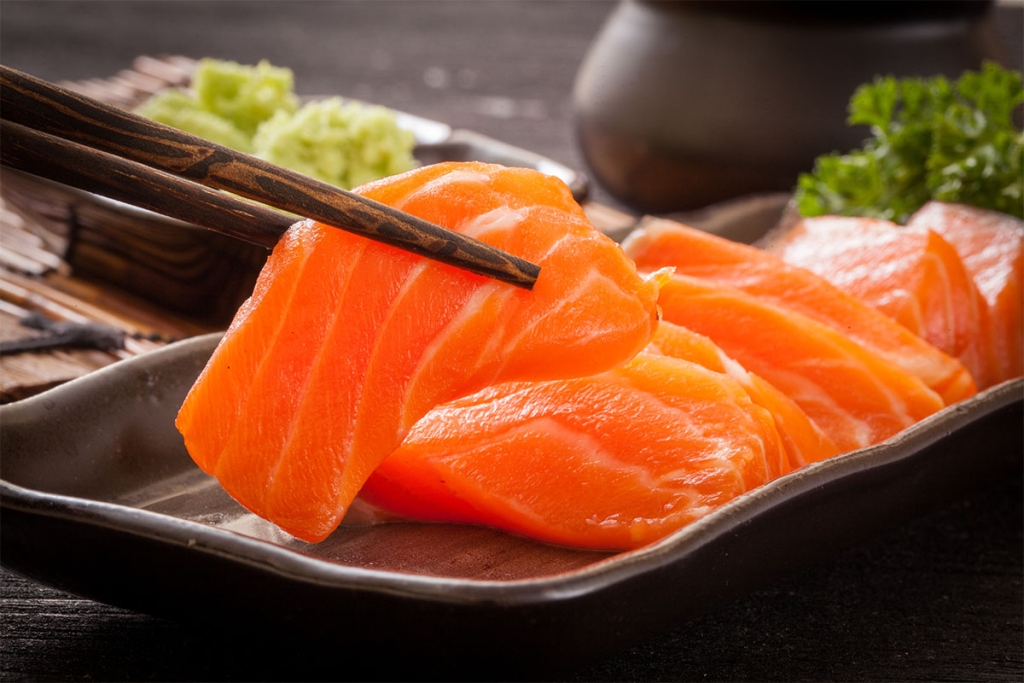
CALORIES IN SUSHI: THE FACTS
When most of us think of sushi, we do tend to think of a ‘healthy’ food.
And it’s true – many fish and seafood including raw salmon, mackerel, herring, tuna and crab are an excellent source of protein and Omega-3s. The nori seaweed used in the sushi rolls, seaweed salad and miso soup is rich in magnesium, calcium, folic acid, iron, iodine and various antioxidants.
However, there are a variety of ways that some of the most popular sushi rolls and other types of sushi can pack a whole lot of extra calories that we might not be aware of.
In seeking out calorie counts online, different sources seem to disagree heavily on the caloric values of most sushi dishes. While some websites call sushi a healthy diet food, others warn of high calorie and sodium intake that we might not suspect. This is because some of our favorite treats at the Japanese restaurant do really add up in extra calories.
With a little pre-planning, however, you can make the healthiest choice with lower-calorie options. Let’s have a look at some of the most healthy options and worst choices at your favorite sushi spot, and what high calorie culprits to watch out for!
HIGHEST CALORIE SUSHI
As you may have suspected, some of the sushi dishes with the highest calorie content are the rolls.
While super tasty, these are often packed with mayonnaise or cream cheese, topped with sugary sweet sauce or battered and fried in tempura. They also may contain more white rice than you’d think! Let’s have a look at the breakdown:
- Mayonnaise – Adds up to 90 calories per tablespoon
- Cream Cheese – Adds up to 51 calories per tablespoon
- Soy Sauce – Adds up to 70 calories per 3.75 oz and a TON of sodium
- Eel Sauce – Is basically soy sauce and sugar
- Sushi Rice – Most sushi rolls will contain a whopping cup of white rice per roll or more! If you’ve ever seen one made, you’ll witness how this particular type of rice can be packed and smooshed down unlike any other, allowing the chef to really pack in the carbohydrates. One cup of sushi rice contains about 422 calories. And that’s just the rice! Brown rice is an option at some restaurants, and while healthier because of the additional fiber, has a similar calorie count to white rice.
The average sushi roll with raw fish, white rice, avocado and seaweed ranges between 300 – 400 calories per 6 – 8 piece roll. Let’s have a look at some of our favorite rolls and their calorie breakdown:
- Philadelphia Roll – Raw salmon avocado roll with cream cheese – 300 calories
- Spicy Tuna Roll – Raw tuna, avocado and spicy mayonnaise – 300 calories
- Eel and Avocado Roll – 372 calories
- Shrimp Tempura Roll – Shrimp inside and then battered and deep fried – 508 calories
- Rainbow Roll – Avocado and/or crab inside with avocado and large pieces of fish on top – 476 calories. But here the additional calories come from avocado and fish.
When choosing rolls, it can be helpful to keep the following in mind:
- “Spicy” generally means mayonnaise with spicy pepper
- “Crispy” indicates that something has been fried like Shrimp Tempura or that there are tempura flakes on top
- “Tempura Roll,” “Spider Roll,” and “Dragon Roll” are code for breaded and fried – these are about as healthy as a French fry
OTHER SUSHI HEALTH CONCERNS
Apart from being deceptively high in calories, there are a few other concerns when eating sushi that are important to note. It can also boost sodium intake because of the soy sauce, so it’s important to choose reduced sodium soy sauce. It’s important also to be mindful that even fresh fish like raw tuna, salmon and mackerel can contain high mercury levels. Health Magazine states that you’d have to be eating sushi more than 6 times per week to get enough mercury in your diet to make you sick. But, if you are pregnant, raw seafood must be avoided since it takes a lot less mercury to be harmful to an unborn fetus.
BEST LOW CALORIE SUSHI OPTIONS
If you wish to escape the sushi place without eating too many calories, sad as it is, it’s best to avoid the rolls altogether, even vegetarian options like cucumber rolls.
Below are some rice and rice-free options to help you keep calorie intake under control:
WITH RICE
If you just can’t palate your sushi without at least a little rice, here are two options that allow you to keep your rice consumption under control.
Nigiri – This is a piece of fish laying on top of a ball of rice. Each piece has about 60 calories. However, if you can’t feel full on about 6 pieces or less, you may be in for more calories than you planned. To cut back on the rice somewhat, you can choose to eat only about half of the rice in each piece of nigiri.
Chirashi – This is a bed of sushi fish (sashimi) on top of a bed of rice. Sometimes chirashi also includes egg and sweet sauce, so do beware of those additives. If you choose this option, it may allow you to be more in control of the amount of carbohydrates you intake.
WITHOUT RICE
Sashimi – This is raw fish without any rice or carbohydrates, often served on a bed of vegetable like peeled carrot, cucumber, seaweed or daikon radish, all of which are very low calorie and will help you fill up. Per ounce, sashimi calories range from about 25 calories (for white fishes, sea bass, etc.) to around 60 calories (for mackerel, tuna, eel and fattier fish like salmon). To give your raw fish some flavor, dip it in reduced sodium soy sauce and wasabi (spicy paste).
Miso Soup – This is a small bowl of soup made of tofu, green onion and seaweed. At only 70 to 80 calories, it’s a nutritious choice to accompany your sashimi and it will help fill you up!
Seaweed Salad – Another great accompaniment to your sashimi order and one of the healthiest options at the sushi joint, this is a tasty and nutritious salad with fresh vegetables at only 130 calories per cup.
With a little careful planning and advanced knowledge your trip to the sushi restaurant can be a great time to get those healthy omega-3s into the diet. In our X-Factor Meal Plans that accompany all of our ATHLEAN-X programs, fish and lean protein are integral parts of our balanced diet. We recommend you eat 5 – 6 times per day and include lean protein at every meal. This will not only help you speed up your metabolism to burn fat faster, but will also give your muscles the energy they need to work their hardest during your workouts.
Looking for a nutrition plan that helps you make the best choices for your fat loss and nutrition goals? Our X-Factor Meal Plan that comes with every one of our ATHLEAN-X programs makes it easy for you!
There’s no counting, measuring or tracking involved! Check out this helpful tip for how to divide up your plate for best results, and then read on to see how our X-Factor Meal Plan helps you tailor your nutrition to your specific goals!







